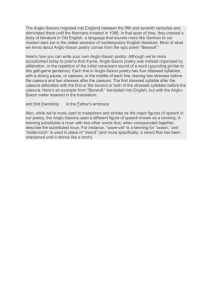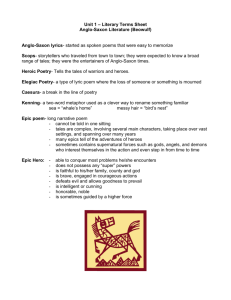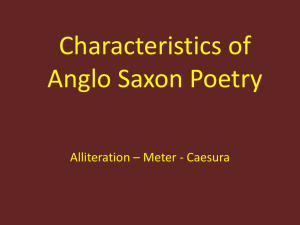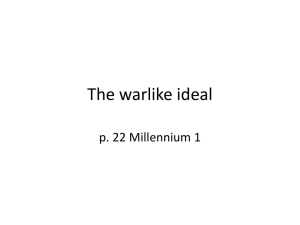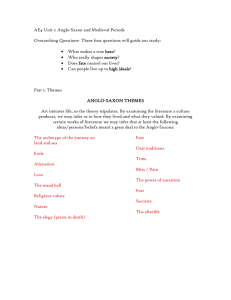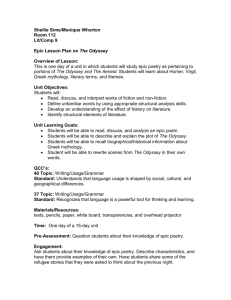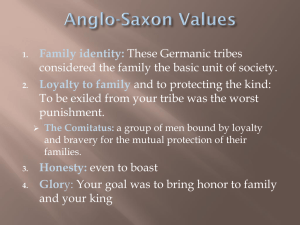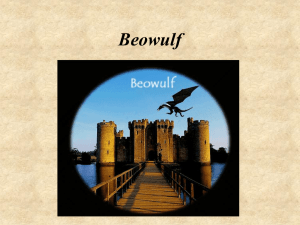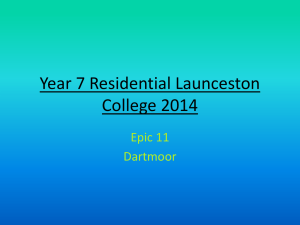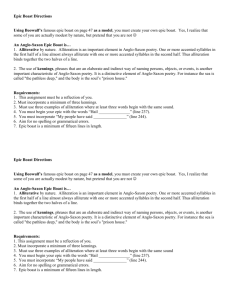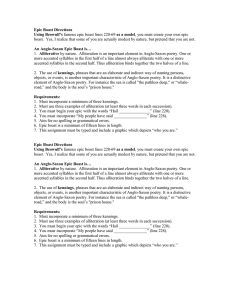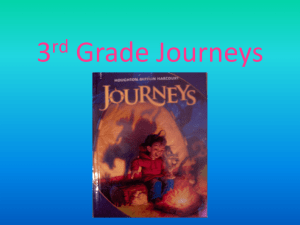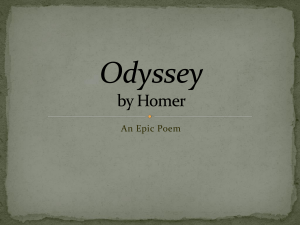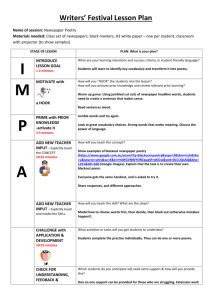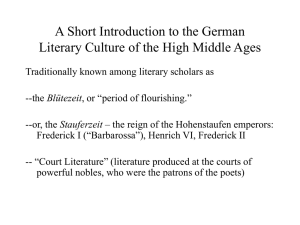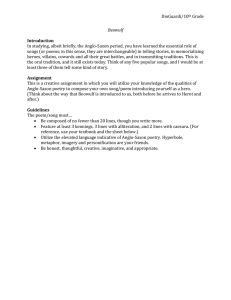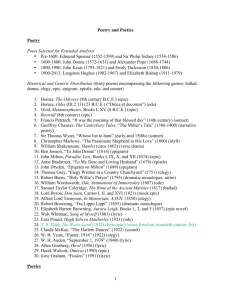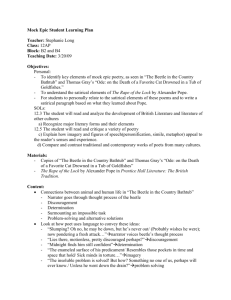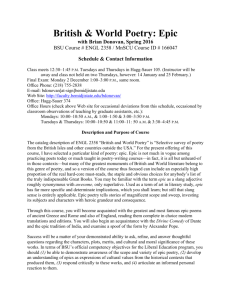Exam Review College Vocabulary: Review 1
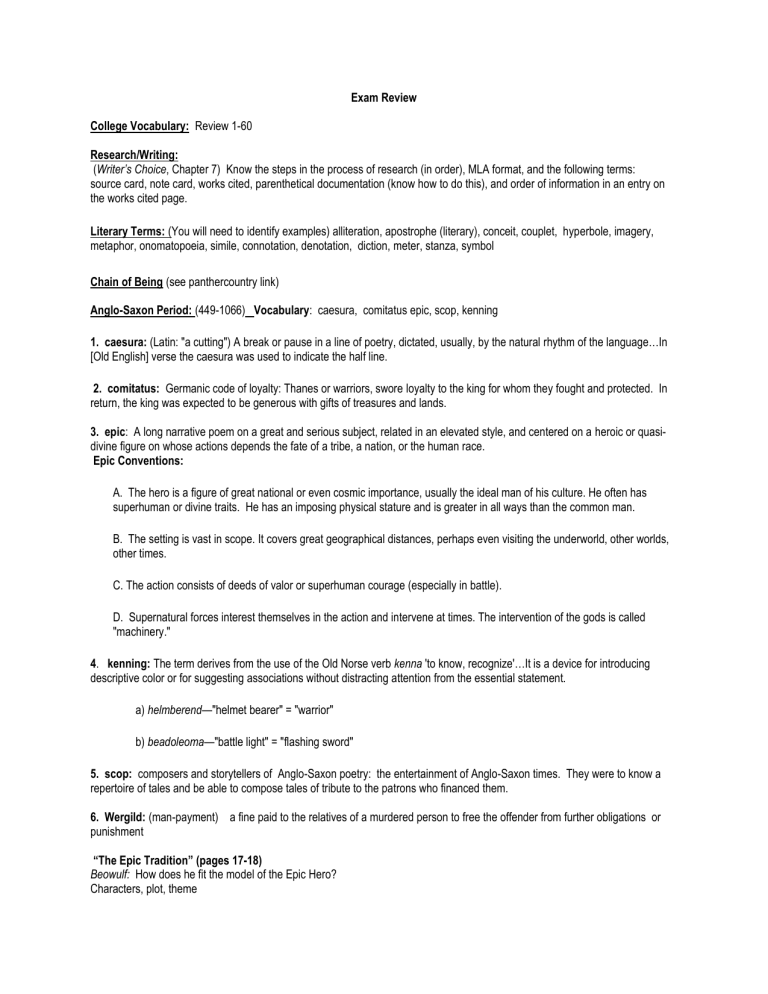
Exam Review
College Vocabulary: Review 1-60
Research/Writing:
(Writer’s Choice, Chapter 7) Know the steps in the process of research (in order), MLA format, and the following terms: source card, note card, works cited, parenthetical documentation (know how to do this), and order of information in an entry on the works cited page.
Literary Terms: (You will need to identify examples) alliteration, apostrophe (literary), conceit, couplet, hyperbole, imagery, metaphor, onomatopoeia, simile, connotation, denotation, diction, meter, stanza, symbol
Chain of Being (see panthercountry link)
Anglo-Saxon Period: (449-1066) Vocabulary: caesura, comitatus epic, scop, kenning
1. caesura: (Latin: "a cutting") A break or pause in a line of poetry, dictated, usually, by the natural rhythm of the language…In
[Old English] verse the caesura was used to indicate the half line.
2. comitatus: Germanic code of loyalty: Thanes or warriors, swore loyalty to the king for whom they fought and protected. In return, the king was expected to be generous with gifts of treasures and lands.
3. epic: A long narrative poem on a great and serious subject, related in an elevated style, and centered on a heroic or quasidivine figure on whose actions depends the fate of a tribe, a nation, or the human race.
Epic Conventions:
A. The hero is a figure of great national or even cosmic importance, usually the ideal man of his culture. He often has superhuman or divine traits. He has an imposing physical stature and is greater in all ways than the common man.
B. The setting is vast in scope. It covers great geographical distances, perhaps even visiting the underworld, other worlds, other times.
C. The action consists of deeds of valor or superhuman courage (especially in battle).
D. Supernatural forces interest themselves in the action and intervene at times. The intervention of the gods is called
"machinery."
4. kenning: The term derives from the use of the Old Norse verb kenna 'to know, recognize'…It is a device for introducing descriptive color or for suggesting associations without distracting attention from the essential statement. a) helmberend—"helmet bearer" = "warrior" b) beadoleoma—"battle light" = "flashing sword"
5. scop: composers and storytellers of Anglo-Saxon poetry: the entertainment of Anglo-Saxon times. They were to know a repertoire of tales and be able to compose tales of tribute to the patrons who financed them.
6. Wergild: (man-payment) a fine paid to the relatives of a murdered person to free the offender from further obligations or punishment
“The Epic Tradition” (pages 17-18)
Beowulf: How does he fit the model of the Epic Hero?
Characters, plot, theme
Anglo-Saxon poetry: Review “Notebook” page 61 (elegy, themes)
Re-read “Read with a Purpose” and “Building Background” for each of the following:
“The Seafarer” (62)
“The Wife’s Lament” (66-67)
“The Wanderer” (68-69)
Medieval Period (Middle Ages) (1066-1485) Vocabulary: (Middle English, iambic pentameter, meter, characterization, allegory, morality play)
Canterbury Tales (Introduction pages 118-119)
“Prologue,” “ Pardoner’s Tale,” “ Wife of Bath’s Tale”
Everyman (Read 217)
Renaissance Period: 1485-1660 (Vocabulary: humanism, carpe diem poetry, pastoral poetry, metaphysical poetry, paradox, parable, anecdote, proverb, maxim, in medias res, allusion, muse, epic simile)
Protestant Reformation (255-261)
Renaissance Poetry (267-268)
Review the poems by the following authors (through page 314) Reread poems/ “Read with a Purpose”/ ” Background”
Sir Thomas Wyatt
Edmund Spenser
Christopher Marlow
Sir Walter Raleigh
Robert Herrick
Andrew Marvell
John Donne
Ben Johnson
Paradise Lost by John Milton
Shakespeare: (sonnet, quatrain, couplet, rhyme scheme, meter, iambic pentameter, turn; Petrarch and Shakespearean sonnet comparison (400)
· Hamlet will not be on the semester exam
